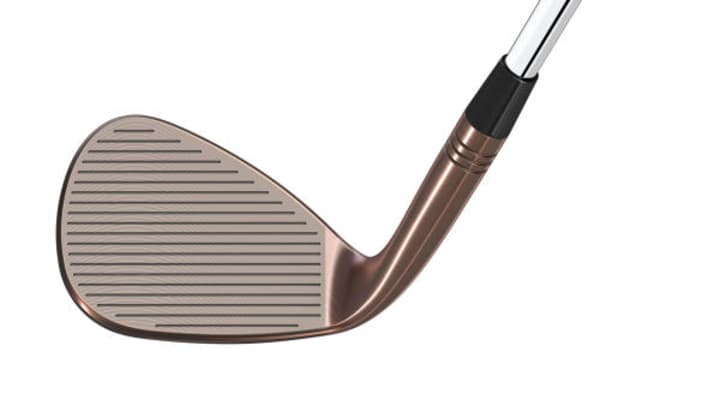TaylorMade puts new face on wedges

One in a weekly series of stories about golf gear to run each Wednesday.
By Gary Van Sickle
The sand wedge is the most boring club in golf, especially considering its importance. No other piece of golf equipment has changed less dramatically in the past 80 years except maybe the tee.
Gene Sarazen often is credited with inventing the sand wedge for Wilson Golf, but that’s not quite right. When in doubt about all things golf, always bow to Scotland. Some savvy Scots carried special clubs for getting out of the sand back in the 1800s, bludgeon-like implements that wouldn’t be out of place in a “Braveheart” battle scene.
What Sarazen did was invent the modern sand wedge. It had a steel shaft, punchmarks on the face instead of scoring lines, and a flange that created about 10 degrees of bounce, still the industry standard in 2018. Sarazen got the idea for the flange, he told his daughter, Mary Ann, when the iconic Howard Hughes took him for a flight and Sarazen noticed how the wing flaps changed position during takeoff. Sarazen thought if he could make a sleeker club, more like a wing, it could glide through the sand easier.
Wilson built the club to his specs, Sarazen used it to win the 1932 U.S. and British Opens, and the sand wedge soon became part of every player’s bag.
Sand wedges are like men’s razors in the 21st century. They are redesigned and altered to look sexier or more effective, but they don’t really change. The basic shape and size stays the same, because that’s what works.
That’s a long way of saying that there’s nothing completely new in the world of sand wedges, not counting the occasional side trip like The Alien, an oddly shaped wedge that marketed its uniquely ugly shape as an advantage. The big advances were the rise of the 60-degree wedge sometime in the 1980s and, later, the introduction of the 64-degree wedge as the world’s best players sought to fine-tune their wedge play to precise yardages.

COURTESY OF TAYLORMADE
TaylorMade’s Hi-Toe wedge features an expanded toe area and scoring lines across the entire clubface.
Like most of its predecessors, the new TaylorMade Milled Grind Hi-Toe sand wedges ($169 suggested retail, www.TaylorMadeGolf.com) borrow from the past. They look a little like the old Ping Eye2 sand wedge and also like Callaway’s more recent Mack Daddy PM Grind Wedge.
TaylorMade has come a long way in sand wedges, although its appeal in that category has paled in comparison to its market success with drivers, fairway woods, irons and putters.
I used two pairs of TaylorMade wedges in the mid-2000s that I gave up only grudgingly after I’d worn out the grooves. They were in my bag along with TM’s r7 irons, which were the best irons I had owned up until that time.
I’ve used many other wedges in the past decade, from Adams to Titleist to Mizuno to Cleveland, so it’s interesting to see how TaylorMade’s newest offering is different.
First, as the Hi-Toe name suggests, the club has an expanded, oversized toe area. Second, the scoring lines on the face (17 of them) run all the way across the face. Not that you’d ever hit a lousy shot off the toe of your wedge – Oh, no, certainly not! – but if you did, hypothetically, you’d get the benefit of scoring lines providing more spin on the aforementioned shot that never happened.
For better players, the toe area is where some of the more challenging shots happen on purpose--lobs and flops--so the bigger toe and its longer scoring lines should make those easier to pull off. Because the Hi-Toe is made for those shots, and it is only an addition to the existing TM line of sand wedges, it comes only in high lofts: 58, 60 and 64 degrees.
I had a short stint with the Hi-Toe wedges at a demo day, and I was impressed. On bunker shots, the Hi-Toe slid through the sand like a lava-hot knife through butter – very satisfying. For chipping around the greens, the club, with its crescent-shaped sole, let me adjust easily to whatever kind of misguided shot I wanted to attempt. It’s versatile, in other words, which I like, and the soft carbon steel face provided the just-right feel.
Top PGA Tour players such as Dustin Johnson, Rory McIlroy, Justin Rose and Jon Rahm are carrying the Hi-Toe wedges this year.
Of course, those guys are so good that they could get up and down with a dustpan … another piece of equipment that hasn’t changed much in 80 years.
Gary Van Sickle has covered golf since 1980 for Sports Illustrated and Golf.com, Golf World and The Milwaukee Journal. Email: gvansick@aol.com; Twitter: @GaryVanSickle
